Long haired rabbits,
Have been prized for hundreds of years. But few people
appreciate the effort that will be required to maintain
the coat of these very special bunnies and rescue centres
are taking in increasing numbers of long-haired rabbits
with neglected coats.
| ANGORA |
the
angora has a long, silky coat that can be spun into
fine wool. |
| SWISS
FOX |
medium-large
breed with upright ears, Swiss fox have a long coat
that lies flat with a parting along the spine. |
| CASHMERE
LOP |
long-haired
dwarf lop with a coat similar to the Swiss fox,
there's also a cashmere version of the miniature
lop. |
| LION
HEAD |
recent
creation with a "ruff" of long hair around
the head and sometimes on the flanks. It's not clear
yet whether Lionhead litters also contain rabbits
with long hair all over. |
| WOLLIES |
woollies
are throwbacks: their short coated parents carried
the recessive long-haired gene. Woollies are the
most difficult long haired to care for. Keeping
them free from mats is such a struggle that some
experts feel they are best put down as soon as they
are identified as babies. |

WHY GROOMING IS SO IMPORTANT
To remove loose hair and mats.
To allow close examination of the whole rabbit even short
haired bunnies can get matted underneath.
To help you health check and bond with your bunny.
SHORT COAT CARE
Use a soft-bristled brush for day to day care. A weekly
groom is usually enough. Except when bunny is moulting.
Slicker brushes and cat moulting combs are useful for
thick or moulting coats.
LONG COAT CARE
The entire coat (including armpits. groin and tummy and
feet) must be combed or clipped. Grooming takes 20 to
40 minutes a day where as clipping is a lot of work every
4-6 weeks With less work in between.
Grooming
Start with a wide-toothed comb. When you've done the whole
rabbit, repeat with a fine toothed comb. Finish with a
flea comb between the ears. Round the vent, under the
chin, and in the armpits.
Soft brushes are hopeless on long haired Bunnies the top
may look lovely, but there may be a matted mess underneath.
Mats should be teased out with fingers or carefully cut
off- it's easy to cut the skin. Combs with revolving teeth
work well.
Even if you're keeping the coat long. Consider a "sanitary
clip" around the vent area.
Metal-toothed slicker brushes are effective, but can scratch
- take care! Cat moulting combs are great at removing
dead undercoat.
Clipping
Get someone to teach you how to do it safely! Use scissors
2 inches long from pivot to tip. Round bladed scissors
are safer, but won't penetrate mats as well as scissors
with sharp ends. Rest a comb against the skin as protection.
Don't "tent" the skin.
Normal dog clippers clog with rabbit fur. Adapted blades
are available, but costly.
If your rabbit is clipped in cold weather, bring him indoors
or provide a bunny proofed heat lamp or heated mat.

This is the same bunny as above minus his matted
fur
"WE HAVE SEEN MANNY HORRIFIC SIGHTS. RABBITS WITH
HUGE MATTED BALLS OF FUR UNDER THE CHIN WHICH
HAVE PREVENTED THEM FROM LOWERING THEIR HEAD TO
EAT: COATS THAT HAVE BECOME SO TANGLED THAT THE
MATTED FUR HAS PULLED THE LEGS TOGETHER AND THE
ANIMAL HAS BARELY BEEN ABLE TO MOVE. UNDERNEATH THE
MATS IS BLEEDING RAW SKIN"
Tricky Bits
Step up the grooming when bunny starts to moult.
If droppings become small, seek veterinary help.
Young long haired rabbit's can he impossible to keep tangle
free Clip off the baby coat and keep the coarser adult
coat groomed as it appears.
Neutered rabbits are happier healthier pets but neutering
may, make the coat more woolly and difficult to care for.
Don't keep long haired bunnies on wood shavings: use a
thick layer of hay or straw instead. Fix a weld mesh cover
onto litter trays
Don't allow long haired rabbits outside in wet weather.
Unhandled rabbits may find the whole process so distressing
they have to be de-matted under sedation or general anaesthetic.
Introduce grooming into your bunny's routine as soon as
possible short sessions at first!
Get help if you are struggling to cope with your rabbit's
coat. Rabbit rescue centres and breeders of long haired
rabbits will probably be able to help. Some accept rabbits
for clipping for a small fee.
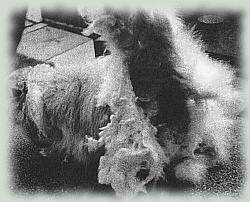
Matted fur being removed from neglected cashmere
lop.
ETHICAL DILEMMAS
However much we may admire magnificent long haired rabbits,
we must ask ourselves whether it is right to create animals
with fundamental welfare problems. Even properly groomed
long coated rabbits are at increased risk of serious health
problems such as fur balls and fly strike. They are also
uncomfortable in hot weather.
There are not enough homes available for thousands of
"normal", short-coated rabbits, let alone these
demanding long haired creatures. No one should ever breed
from a long haired rabbit without first considering how
difficult it is to find the very special homes needed
by these very special bunnies.
This rabbit is at very high risk of fly strike unless
all the caked faeces are removed.
"RABBITS ARE BECOMING THE SECOND MOST COMMON ANIMAL
DUMPED ON US MANY ARE LEFT BECAUSE THEIR OWNERS
CAN'T COPE WITH THERE LONG COATS. THEY'RE DIFFICULT
FOR US TO COPE WITH AND WE NEED VERY SPECIAL ADOPTERS
TO TAKE THEM ON AND CARE FOR THEM PROPERLY PROSPECTIVE
OWNERS SHOULD THINK LONG AND HARD BEFORE ACQUIRING A LONG-HAIRED
RABBIT
Flystrike
Any rabbit (but especially those with long hair) whose
coat becomes soiled with urine or faeces is at risk of
fly strike. This gruesome -Condition occurs when flies
lay eggs on the soiled fur, which hatch into maggots and
literally eat the rabbit alive. This can happen within
hours in warm weather.. Always check your rabbit's bottom
daily.
"1 HAVE NEVER SEEN A LONG-HAIRED RABBIT WITH A
WELL CARED-FOR COAT SEVERAL HAVE BEEN PRESENTED TO ME
"UNWELL", AND ON EXAMINATION THEIR BODIES HAVE
BEEN COVERED WITH A SINGLE MAT OF HAIR, like A THICK BLANKET
GLUED TO THEIR BACK, UNDERNEATH WHICH WAS A SEETHING MASS
OF MAGGOTS" (VETERINARY SURGEON, NORTHUMBERLAND)
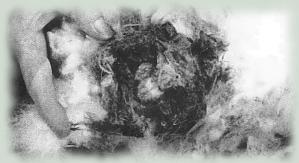
This rabbit is in a very real danger of fly strike,
unless the caked faeces are removed.
WHAT YOU CAN DO
Ask your local pet shop (or write to the head office of
pet superstores) to make a policy never to sell long haired
rabbits. They are simply too specialised to be obtained
from anyone other than a rescue centre or expert breeder.
If you have a long haired rabbit, please don't breed from
it. Make a donation (payable to the BHRA Rabbit Welfare
Fund) towards the cost of producing rabbit welfare leaflets.
Support your local rabbit rescue. Every year around 25,000
rabbits end up in rescue centres - if you're thinking
of obtaining a rabbit why not save a life and adopt a
rescued bunny?
THE BRITISH HOUSERABBIT ASSOCIATION
If you love rabbits, why not join the BHRA? Membership
includes: Our fabulous quarterly magazine Rabbiting On
packed with health, behaviour and care advice to help
you build a wonderful relationship with your bunny - whether
s/he lives indoors or out.
BHRA handbook
Rabbit advice from our national network of advisors
Social and educational events
Unique regional Rabbit Runner directory of useful
contacts including bunny boarding. Rescues, and "rabbit
friendly" vets.
A great range of rabbit-themed gifts available from the
BHRA shop.
Please visit the House Rabbit association online at
http://www.houserabbit.co.uk
For information and donations,
Or to contact us please click here.
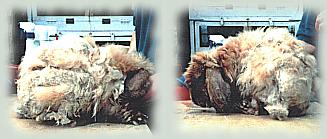
This is Humphrey he came in to care in a poor state and
after clipping was a little brighter.

And considerably more handsome.
TRUST PET PRODUCTS RABBIT FEED
as reccomended by
THE RABBIT AND GUINEA PIG WELFARE
We at the Rabbit and Guinea Pig Welfare have been doing
a lot of research into the rabbits diet recently. We found
not only were we feeding excessively we were feeding incorrectly.
We were feeding a very well known brand of rabbit mixed
food, there was absolutely nothing wrong with the general
contents of the mix as long as the rabbit ate every
little bit. When feeding a mixed food the rabbit must
eat everything in its bowl. Our experience with rabbits
is that they will pick out the bits they like (flaked
peas especially) and discard the rest. Us owners are not
totally blame free either, we see a half full bowl so
we top it up, the rabbit then has more nice bits to eat.
How many of you like me when I clean the hutch empty the
bowl and refill it with fresh mix? We should not do this.
We receive many calls from people that have rabbits that
have constantly soiled bottoms.
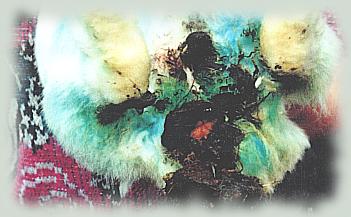
The blue around this bottom is antiseptic spray,
to try and avoid fly strike.
or mallocluded (overgrown) teeth.
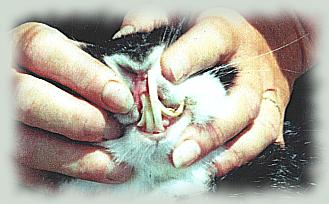
Most times this is due to incorrect diet. How many of
us actually know what nutritional values our rabbit mix
should have? I certainly didn't.
When you next buy your rabbit food read the label. Firstly
the sell by date. The vitamins in food can quickly deteriorate
never buy more than you can comfortably use in three months,
or by the sell by date. Always store the food in a cool,
dry place in an airtight container. Next, check the nutritional
value, the following amounts are what you should expect
to feed for adult maintainance, (if you require amounts
for expectant does or raising young I will be happy to
send them to you).
OIL content 3%. PROTEIN content 13%. FIBRE
content 15%. MINERALS should be 4mg per
kg of rabbit, normally shown as Copper. VITAMIN A
content 6000iu/kg. VITAMIN E SOiu/kg. VITAMIN
D3 lOOOiu/kg.
We have not found a food with the all exact amounts but
these figures should be used as a guide line. Fibre in
a diet is very important, it helps to work the gut properly,
if you have a rabbit that suffers with a soiled rear check
that the fibre content in the food you use is high enough,
(bearing in mind that it should be eating all of
the food provided not picking out its favourite bits).
We have started to use a food called T.P.P. RABBIT.
In our opinion it is the best we could ~md. When using
any commercially bought rabbit food only feed enough each
day so that the bowl is empty when you come to feed next
time. If there is food left you are feeding too much,
this will lead to an overweight and lethargic rabbit.
On alternate days we feed a product called READI GRASS
which is a naturally dried grass that has a very high
fibre content of 30%.We have had great success with this
feeding regime, we have not had a problem with 'sticky
bums' and the rabbits whole appearance is much better.
Both these products can be supplied and delivered by;
Trust Pet Products, Unit 15 Hiron Way, Budbrooke Industrial
Estate, Warwick, CV34 5WP. Tel: 01926 495201 Fax: 01926
499050
If you experience difficulty obtaining these products
you can contact;
Mr. John Wright for the Rabbit Food on 01832 731311 and
the Spillers Hotline for the Readi Grass on 01908 226626.
Remember that in addition to the commercial products your
rabbit should always have a supply of fresh hay and fresh
water at all times. A variety of forage (fresh veg, fruit
and wild plants) should also be available to your rabbit
every day. This will provide added fibre to aid a healthy
digestive system and will provide abrasive material that
will help to wear your rabbits teeth down evenly.
If you are going to change your rabbits diet do it gradually.
Mix a little of the new food in with your existing product
and gradually increase it until you have changed the diet
completely. NEVER change the diet immediately, a rabbit
has a very delicate digestive system and a sudden change
in diet will disrupt the digestive flora and your rabbit
will become very ill.
A FEW RESONS TO HAVE YOUR RABBIT NEUTERED
Female Rabbits
By the age of 5 years up to 50% (some studies suggest
95%) of female rabbits have a chance of developing uterine
adenocarcinoma.
Uterine infections (pyometra) are common in females over
a year of age.
Spaying removes all the behavioural problems associated
with:- sexual maturity, such as nesting, mounting, aggression,
spraying and mood swings.
Neutered rabbits are easier to litter-train.
Neutered females can live in the company of males (preferably
also neutered).
Prevents unwanted litters.
Male Rabbits
Castration eliminates the behaviour changes associated
with sexual maturity such as mounting, spraying and aggression.
Neutered male can live with a female (preferably neutered).
Easier to house-train, and less smell (essential if a
house rabbit).
Prevents unwanted breeding.
THANK YOU TO THE RABBIT CHARITY FOR THE USE OF THIS
DOCUMENT. Visit them at
http://www.therabbitcharity.co.uk
IF YOU HAVE ANY ENQUIRES OR CONCERNS
ABOUT NEUTERING YOUR RABBIT, PLEASE FEEL FREE TO
ASK FOR OUR ADVICE HERE
WE AT THE RABBIT AND GUINEA PIG WELFARE, HAVE DECIDED
TO HAVE ALL OUR ANIMALS NEUTERED BEFORE REHOMING, ALSO
OUR RABBITS ARE ALL VACCINATED AGAINST BOTH THE MYXOMATOSIS
AND VIRAL HEAMORRHAGIC DISEASE.
VHD (VIRAL HEAMORRHAGIC DISEASE)
Viral Haemorrhagic Disease was first reported in the UK
in 1992 and has since spread throughout the country. The
virus is easily spread between rabbits or via contaminated
hutches, bedding or food. It can also be inadvertently
transported by people or birds. Studies have shown that
the virus can survive for at least three months on clothing.
VHD only affects rabbits and, in general, only those over
6 weeks of age. 90% of infected rabbits develop clinical
symptoms which vary, including loss of appetite and nose
bleeding. The disease progresses rapidly so it is important
to contact your veterinary surgeon as soon as your rabbit
show signs of being ill. Nearly 50% of rabbits which catch
the disease die and death is often sudden, without warning.
The acute form of the disease can be very distressing
as blood clots develop on the lungs and the rabbit is
unable to breathe. Over 60% of recorded deaths due to
VHD have been pet rabbits. When you care about your pet
rabbit you obviously want to protect it against this serious
fatal disease. Don't wait. One dose of vaccine will protect
your rabbit for a full 12 months.
Your veterinary surgeon will give you the best advice
as to when to start vaccination - the first dose may be
given from 2½ - 3 months of age or even earlier
in some cases.
Protection from an initial vaccination does not last for
ever and the immunity will wane over the year. To maintain
protection and ensure that your pet does not become susceptible
to the disease, annual booster vaccination is essential.
Millions of doses of vaccine have been sold in Europe
and it is safe to use, even in pregnant rabbits. Just
like any of us, rabbits may occasionally react adversely
to vaccination but such side effects are rare and almost
always of a fairly minor nature.
When your rabbit is given it's first vaccination our veterinary
surgeon will give you a Record Card detailing the diseases
it has been vaccinated against and the date that the yearly
booster will be due. It is important to keep the Record
of Vaccination Card in a safe place as it may be required
at rabbit shows, for breeding or as proof that your rabbit
has been vaccinated. The Record Card should be presented
to your veterinary surgeon each year at the time of booster
vaccination so that it can be kept up-to-date.
Protection from the initial dose of vaccine does not
last for life.
To maintain protection it is essential that you return
your pet for a booster vaccination once every year.
Without regular booster vaccinations your pet can become
susceptible to disease. Before your pet is vaccinated
a routine health check will be carried out. This check-up
is an important part of maintaining the good health of
your pet.
The Record of Vaccination Card is an important document.
Please keep it in a safe place and take it with you when
you visit your veterinary surgeon, or when your rabbit
is taken to shows.
MYXOMATOSIS What causes myxomatosis?
The disease myxomatosis in rabbits is caused by virus.
The virus is a type of pox virus which grows best in the
skin of rabbits. Like all viruses the organism is minute
and can only be seen under the electron microscope. What
are the signs of myxomatosis? The very first signs
we can see are puffy, fluid swellings around the head
and face. 'Sleepy eyes' are a classic sign along with
swollen lips, tinv swellings on the inside of the ear
and puffy swellings around the anus and genitalia. Within
a day or so, these swellings can become so severe as to
cause blindness and there may be some distortion around
the face, mouth. ears and nose. Which rabbits are susceptible
to myxomatosis?
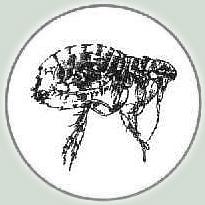
In this country; the European rabbit (oryctolagus) is
highly susceptible to the disease. The European Brown
hare is sometimes, but rarely, affected with myxomatosis.

What breeds of rabbit are affected?
All breeds of rabbit are affected, including; our wild
rabbits found in the country. all breeds of pet and show
rabbits including Dwarf rabbits, Lop Eared rabbits and
Exotics. There is little evidence that one breed is more
susceptible than another.
Where did myxomatosis come from?
originally, myxomatosis was imported from Brazil (where
it was first discovered in the 1930's) to Australia in
1950. This was to control the massive population in that
subcontinent. In Brazil, the Cotton Tailed rabbit (Sylvilagus)
is affected by the disease to a minor degree as only tiny
lumps are produced by this self-limiting disease. However,
in Australia the disease was devastating and markedly
reduced the rabbit population.
How did the disease get to Britain?
The disease was transmitted from Australia by a French
Phvsician. Dr A Delille, who wished to control the rabbit
population on his country estate near Paris. The disease
rapidly spread into the wild population in France and
then was brought, entirely by accident, from France in
1953. There is no evidence that the disease was intentionally
brought into Britain bet there is no doubt that some farmers
moved the disease around using diseased rabbits to control
the population of the rabbits locally.
How is the disease spread?
Myxomatosis is spread by blood sucking insects. A major
insect parasite which transmits the disease in this country
is the rabbit flea which is frequently found on wild rabbits
although is less common on pet rabbits. In other countries,
including some European countries, it is known that mosquitoes
are a major insect vector of myxomatosis. Although this
has never been proved in Britain, there is strong circumstantial
evidence that mosquitoes transmit myxomatosis in the UK.
Incidentally, myxomatosis is not easily spread
by simple contact from one rabbit to another. For instance
if a rabbit is placed in the same hutch as a healthy rabbit
and neither animal is parasitised by fleas or mosquitoes,
then the disease is virtually never transmitted by contact.
Myxomatosis virus can remain alive in the blood of fleas
for many months and it is probably by over-wintering of
fleas in rabbit burrows that the disease is transmitted
from year to year.
What happens when a myxomatosis-infected flea bites
a susceptible rabbit?
As the mosquito or flea bites the rabbit a small amount
of the live virus is placed in the skin of the rabbit
as the insect sucks blood. Within a few days the virus
is transmitted to a local lymph node and then passes into
the blood of the rabbit which enables it to be moved around
to several sites. The virus mainly multiplies in the skin
around the eyes, the nose, and face, the soft skin inside
the ears and also the skin around the anus and genitals
of the rabbit.
What is the incubation period of myxomatosis?
The incubation period varies slightly from one animal
to another but can be as short as five days and as long
as fourteen days (incubation period is the time from the
point introduction of the virus into the animal to the
first time that clinical signs of illness are seen).
After infection how long do rabbits usually survive?
This also varies. Some animals may survive for weeks or
months after infection but, in general, if an infection
is severe in a susceptible rabbit, death occurs within
12 days.
How does the disease progress?
Within a short space of time, affected rabbits become
blind because of the swelling around the eyes and for
this reason feeding and drinking is often difficult However,
one can sometimes see wild rabbits suffering from myxomatosis
quietly grazing. Of course, at this stage many rabbits
become prey to animals such as foxes and other predators.
Other rabbits may well become injured or killed on roads
but the common cause of death is a secondary lung infection
which often occurs around day 8 after the initial incubation
of the disease. In pet rabbits. the disease often progresses
more slowly and death is not so rapid because of the care
which the owner gives the rabbit.
Do all affected rabbits die?
Not all affected rabbits die ..although recovery is rare
in the wild (probably less than 10% of wild rabbits eventually
recover from myxomatosis recovery may be more common in
pet rabbits with intensive nursing. If care is taken with
feeding, making sure that water is as available and medical
care to combat pneumonia is given, then recovery rates
in pet rabbits are higher than in the wild but are variable
depending on the severity of the disease.)
However, a word of warning - myxomatosis can be a very
protracted disease and affected animals may take weeks
or months to recover Even then there may be severe scaling.
scabbing and scarring on the head and body.
How can the disease be controlled?
The disease can be controlled by two main methods:
1. Control of insect parasites.
2. Use of vaccines.
Controlling insects
Flea control is important and may involve not only keeping
wild rabbits away from pet animals but also positive use
of flea control measures such as sprays, dips and insect
repellent strips. Incidentally, there is some evidence
that the domestic cat, which can often be affected with
rabbit fleas, may be a secondary transmitter of the rabbit
flea. Obviously, isolating pet rabbits from possible close
contact with wild rabbits is sensible. Do not forget to
control mosquitoes - it may lie possible to use mosquito
nets and insect repellent strips. Care should be taken
that the bedding of animals is kept dry and that pet rabbits
are not kept in moist conditions which favour mosquito
conditions. veterinary surgeons will be able to give advice
on flea and mosquito chemical control.
Use of vaccine against myxomatosis
In Britain the licensed vaccine for the control of myxomatosis
is Nobivac Mvxo. This vaccine utilises a virus called
the Shope Fibroma virus which is closely related to the
myxomatosis virus but does not cause disease. Occasionally,
it is possible to see a tiny swelling at the site of vaccination
but usually no signs are obvious after vaccination. This
similar virus induces a degree of protection against myxomatosis.
It is not a new principle to use a similar virus to control
disease. For instance, Edward Jenner made the first successful
vaccination in 1796 against smallpox by immunising a patient
with the cowpox virus. There are several other examples
of related viruses being used to control diseases in animals
and man.
Is this vaccine live or dead?
Myxomatosis is a live vaccine containing the Shope Fibroma
virus. How ever, the virus does not readily spread from
one animal to another and all rabbits in a group should
be individually vaccinated.
Does the vaccine cause disease?
No. Nobivac Myxo does not cause illness in vaccinated
rabbits. The only clinical signs that may be seen are
some times a slight lump at the site of vaccination. This
is a good sign as it shows that the virus has actually
caused a swelling in the skin and this should confer a
strong protection against myxomatosis.
Does vaccination guarantee protection against disease?
No, vaccination can never guarantee protection against
any disease but Nobivac Myxo when properly used, offers
the best available chance of producing immunity against
myxomatosis..
What is the vaccination schedule?
A single vaccination should he given to rabbits over Six
weeks of age. Rabbits should not be vaccinated during
pregnancy. Only healthy-rabbits should be vaccinated.
The vaccine may not be effective in rabbits incubating
the disease at the time of vaccination. Following initial
vaccination rabbits should not be exposed to infection
for at least 14 days. Some animals may be immunologically
incompetent and fail to respond to vaccination.
Are boosters necessary?
Boosters are suggested annually for rabbits which are
not under a heavy challenge from the disease. however,
animals which are likely to be heavily challenged by the
disease e.g. rabbits in a rabbit sanctuary, rabbits close
to wild rabbits with myxomatosis, rabbits with a heavy
flea population or rabbits in an area where myxomatosis
is rife are best vaccinated twice a year. Incidentally,
most myxomatosis in Britain occurs in the late summer,
autumn and early winter months. And giving a single animal
vaccination it is probably best to vaccinate in July or
June so that animals have the best protection during the
autumn and early winter months. however, do remember that
myxomatosis can affect animals during any month of the
year.
Pasteurella
The other important disease is caused by the bacterium
Pasteurella. This can cause a variety or diseases from
the respiratory condition called "snuffles"
through to abscesses of the skin or internal organs. There
is little that can be done to guard against this, but
rabbits in good health with a strong immune system are
unlikely to be affected so good husbandry and regular
veterinary checks are vital.
Fur Mites
Scratchy, flaky skin with bald patches is usually a symptom
of skin mites or an allergic reaction to fleas. Fleas
tend to cluster around the neck and head where you may
find the black specks that are their excreta. The rabbit
fur mite causes a very scurfy, itchy skin complaint with
accompanying loss of fur. The mites are white and just
visible to the naked eve. On a black surface, they look
like "walking dandruff". In each instance,
consult your vet.
|